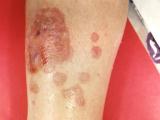May 23, 2002 (CIDRAP News) – Data on recent salmonellosis outbreaks indicate that drug-resistant strains of Salmonella enterica serotype Newport are becoming increasingly common in dairy cattle and are causing a growing share of infections in humans, according to a foodborne disease expert with the Centers for Disease Control and Prevention (CDC).
Fred Angulo, MD, a medical epidemiologist with the Foodborne and Diarrheal Diseases branch of the National Center for Infectious Diseases, said S Newport now accounts for about 10% of human cases of salmonellosis, or an estimated 140,000 cases a year, up from 3% 5 years ago.
A recent report, coauthored by Angulo, of disease surveillance in Massachusetts and Vermont produced evidence that multidrug-resistant (MDR) S Newport has spread from cattle to humans. In addition, Angulo said that a more recent S Newport outbreak in Connecticut was linked with unpasteurized dairy products, and a similar outbreak in New York state within the past 2 months was traced to ground beef from dairy cattle.
"All the investigations together, both investigations of human illness and the information we have on animal illness, indicate that multidrug-resistant Newport has as its major reservoir dairy cattle and is causing illness in humans," Angulo said. While Salmonella infections overall have been declining, S Newport has shown a "remarkable" increase, he said.
The study in Massachusetts and Vermont showed that living on or visiting a farm was the main risk factor for contracting an MDR S Newport infection. The report was presented at the CDC's Epidemic Intelligence Service Conference in Atlanta in April. Angulo, the report's senior author, shared authorship with the CDC's Amita Gupta and colleagues from CDC and the Massachusetts Department of Public Health (MDPH).
In the study, all S Newport isolates received between July 1998 and March 2001 were tested for antimicrobial susceptibility and analyzed by pulsed-field gel electrophoresis (PFGE) at the MDPH, according to the study abstract. Isolates were defined as MDR if they were resistant to ampicillin, chloramphenicol, sulfamethoxazole, tetracycline, extended-spectrum cephalosporins, and ampicillin-clavulanic acid. In March 2001, the investigators did a case-control study that included 34 people with MDR S Newport (case-patients), 37 people with antimicrobial-susceptible S Newport, and 94 healthy controls.
Of 120 human S Newport isolates identified between January 1999 and March 2001, 46 (38%) were MDR and 71 (59%) were antimicrobial-susceptible, according to the report. (No MDR S Newport isolates were found in 1998.) Seventeen bovine S Newport isolates were identified in the region in the same period, and all were MDR. The PFGE analysis showed that one pattern accounted for 57% of the human isolates and 64% of the bovine isolates.
More than a third of the case-patients (34%) were hospitalized, the report says. In the week before they became ill, case-patients were more likely than ill controls to have reported bloody diarrhea (52% versus 18%; odds ratio [OR], 4.7; 95% confidence interval [CI], 1.4 to 17.9) and to have had exposure to farms (21% vs 3%; OR, 9.1; 95% CI, 1.1 to 432). Case-patients were less likely than ill controls to have traveled abroad (0% versus 11%, OR undefined). In addition, the case-patients were more likely than healthy controls to have had exposure to farms (22% versus 3%; OR, 16.7; 95% CI, 2.0 to 768.8).
Angulo said other possible risk factors for infection, such as foods eaten, were investigated, but none were confirmed. "Ten percent of the infections could be associated with visiting or living on a dairy farm," he said. The other 90% of infections could not be accounted for.
However, a subsequent outbreak of S Newport infections in Connecticut was associated with cheese made from unpasteurized milk from dairy farms in the same area as those in the Massachusetts-Vermont study, Angulo said. And in the past 2 months, an S Newport outbreak in New York state has been traced to ground beef from a slaughterhouse that received only dairy cattle, he reported.
Salmonella causes about 1.4 million infections per year, and S Newport now constitutes about 10% of the identified isolates, Angulo said. Hence, he said, "It's reasonable to estimate that 140,000 cases of Newport are occurring each year and much of it is multidrug-resistant Newport.
"Our understanding is that maybe 10% of those infections are from visiting or living on a dairy farm, and a comparable percent is due to drinking raw milk or eating soft cheeses," he continued. "Much of the remaining illness is probably coming from the food supply through eating ground beef. There are lots of opportunities for additional studies, but the evidence that we have is that this is causing problems in all the major dairy milk sheds in the country."
Angulo called the increase in S Newport infections "alarming" in view of recent evidence that salmonellosis overall has been declining in the United States. "Despite that decline, Newport has shown this remarkable increase, and there's a danger that Newport may offset the decline of all other Salmonella. And this Salmonella is remarkably resistant, to at least nine antibiotics, sometimes more." The resistance includes third-generation cephalosporins, which are commonly used to treat serious infections, he added.
See also:
Gupta A, Crowe C, Fontana J, et al. Cows, bugs, and drugs: investigation of sporadic illnesses caused by multidrug-resistant Salmonella Newport—Massachusetts and Vermont, 1998-2001. Presented at the 51st Annual Epidemic Intelligence Service (EIS) Conference, CDC, Atlanta, Apr 23, 2002 (abstract found on page 36 of conference program)





















